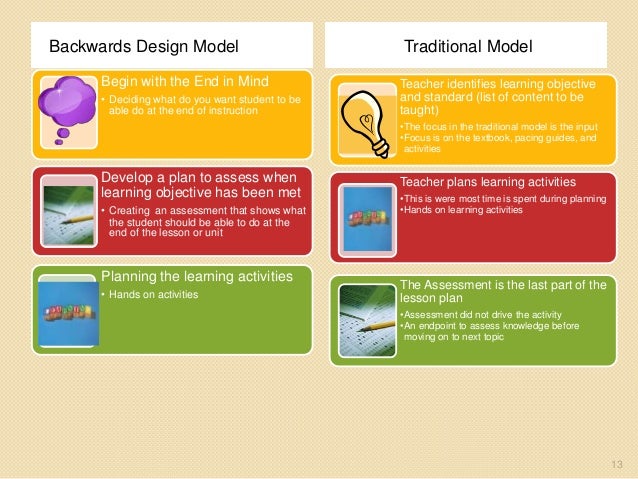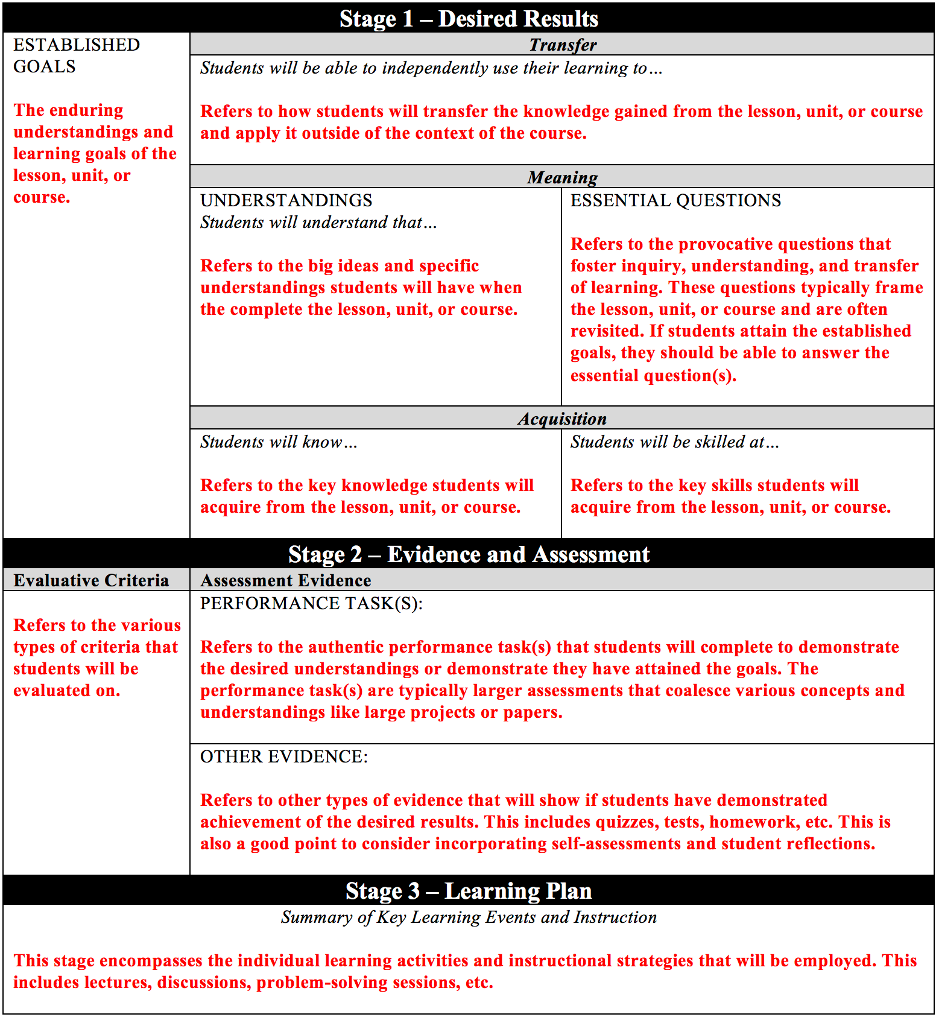3 Basic Steps of Backward Design Lesson Plans +FAQs
Table Of Content

The incorporation of backward design also lends itself to transparent and explicit instruction. If the teacher has explicitly defined the learning goals of the course, then they have a better idea of what they want the students to get out of learning activities. Furthermore, if done thoroughly, it eliminates the possibility of doing certain activities and tasks for the sake of doing them.
QUESTIONS TO ASK BEFORE SELECTING A CURRICULUM DESIGN COURSE

The idea in backward design is to teach toward the "end point" or learning goals, which typically ensures that content taught remains focused and organized. This, in turn, aims at promoting better understanding of the content or processes to be learned for students. The educator is able to focus on addressing what the students need to learn, what data can be collected to show that the students have learned the desired outcomes (or learning standards) and how to ensure the students will learn. Although backward design is based on the same components of the ADDIE model, backward design is a condensed version of these components with far less flexibility. Backward design challenges "traditional" methods of curriculum planning.
Sweetgreen rebrands with new logo, store design - Nation's Restaurant News
Sweetgreen rebrands with new logo, store design.
Posted: Wed, 26 May 2021 07:00:00 GMT [source]
Bloom’s Taxonomy: The Ultimate Guide [Free Download]
By focusing on the end goals—say, improving customer service or increasing sales—trainers can build a program that really works. No more slogging through boring PowerPoint slides that nobody remembers the next day. Instead, employees get active, engaging training that equips them to do their jobs better. This teaching guide is licensed under a Creative Commons Attribution-NonCommercial 4.0 International License. What your students will know and skills they will learn by the end of the course.
Integration into Curriculum Planning
Once you have determined what you want the students to be able to know and do, you’ll define how you will know if the student has achieved those outcomes. What do you want students to know or be able to do at the end — explain how cells work? Backward lesson design begins with identifying a specific desired outcome. Once you figure out your student-focused learning goals, you’ll be better equipped to figure out how best to test for those goals instead of the other way around.

We’re going to break down what backward design lesson planning is and why you should use it. Backward design arose in tandem with the concept of learning standards, and it is widely viewed as a practical process for using standards to guide the development of a course, unit, or other learning experience. Like backward designs, learning standards are a way to promote greater consistency and commonality in what gets taught to students from state to state, school to school, grade to grade, and teacher to teacher.
New way forward? Klein on reversible design - GolfPass
New way forward? Klein on reversible design.
Posted: Mon, 26 Mar 2018 07:00:00 GMT [source]
What is backwards design in a lesson plan?
It continually encourages the instructor to establish the purpose of doing something before implementing it into the curriculum. Therefore, backward design is an effective way of providing guidance for instruction and designing lessons, units, and courses. Once the learning goals, or desired results, have been identified, instructors will have an easier time developing assessments and instruction around grounded learning outcomes. Some teachers may fear that backward design emphasizes “teaching to the test,” which puts unfair pressure on students to learn for the sake of the final assessment. However, it is up to the skilled teacher to emphasize the process of gaining new knowledge, as opposed to acing the final test. While it can be difficult to grasp at first, backward design encourages educators to be intentional with their lesson planning, since it imbues the class time with a specific purpose.
Educational technology experts like Dr. Ruben Puentedura, known for the SAMR model, suggest that technology can play a powerful role in implementing Backward Design. Whether it's digital assessments or interactive activities, technology can offer innovative ways to achieve your learning objectives. Before implementing a new curriculum design strategy like Backward Design, it's often beneficial to consult with school or organizational administrators.
Step 1: Identify the Desired Results
When teachers use Backward Design, they can consult Bloom's Taxonomy to identify the level of cognitive skills they wish students to attain. Whether the goal is simply to remember dates or analyze historical events, Backward Design helps educators map out a targeted learning path to achieve the desired complexity level. Today, Backward Design is not just a trendy term but a key part of curriculum planning in many educational settings. You'll find its principles being applied in lesson plans, educational software, and teacher training programs.
Nor does it ask them to “demonstrate knowledge” of how the whole system works. The standard wants students to develop a model and use it to describe the system. The first and most important problem is a lack of durable, transferable learning. One reason so many of us don’t remember much of what we learned in school is that we learned it through this haphazard, topic-driven approach.
Backward Design serves as more than just a tool for curriculum planning; it represents a shift in how we think about education. Instead of starting with what educators want to do, it starts with what students need to learn. This learner-centered focus makes it a powerful approach for modern education, where student engagement and outcomes are increasingly emphasized. In this model, traditional classroom activities and homework assignments are reversed. Teachers like Aaron Sams and Jonathan Bergmann have popularized this approach, which often involves students watching lectures at home and engaging in activities during class. While the Flipped Classroom also aims for active learning and engagement, it doesn’t necessarily start with specific outcomes in mind, making it different from Backward Design in its initial focus.
The next step is to determine appropriate assessments to demonstrate success with the objectives in place. The final step is where the educator decides which activities and teaching methods are best suited to achieving the learning goal. Wiggins and McTighe identify a link between the assessment format and the type of understanding students need to demonstrate. For example, if the goal is for students to learn basic facts and skills, traditional quizzes and tests might be the most appropriate type of assessment to use.
If your backyard is a jungle or simply boring, you might be dreaming of finally doing something about it—now is the time. A book of photographs of a changing Los Angeles by Pat's father, William Reagh.Published by the Book Club of California. Browse over 500+ educator courses and numerous certificates to enhance your curriculum and earn credit toward salary advancement. In theory, this will mean that every test your students take is relevant and helpful and shows them exactly what they do and do not need to do in order to pass your course. Before we dive into what makes Backward Design so impactful today, it's important to go back in time and see where it all started.

Comments
Post a Comment